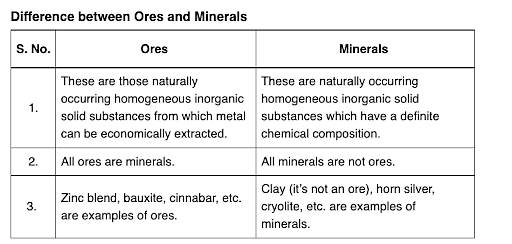Leaching of gold with dilute aqueous solution of NaCN in presence of oxygen gives complex [A], which on reaction with zinc forms the elemental gold and another complex [B]. [A] and [B], respectively are :
- \([Au(CN)_4]^–\) and \([Zn(CN)_2 (OH)_2]^{2-}\)
- \([Au(CN)_2]^–\) and \([Zn (OH)_4]^{2-}\)
- \([Au(CN)_2]^–\) and \([Zn (CN)_4]^{2-}\)
- \([Au(CN)_4]^{2-}\) and \([Zn (CN)_6]^{4-}\)
The Correct Option is C
Solution and Explanation
In the metallurgy of gold
\(4Au + 8CN^– + 2H_2O + O_2 → 4[Au(CN)_2]^– + 4OH^–\)
\(2[Au(CN)_2]^– + Zn → [Zn(CN)_4]^{2–} + 2Au\)
So, the correct option is (C): \([Au(CN)_2]^–\) and \([Zn (CN)_4]^{2-}\)
Top Questions on Concentration of ores
- Which of the following are carbonate ores?
I. Siderite
II. Kaolinite
III. Calamine
IV. Sphalerite- AP EAPCET - 2025
- Chemistry
- Concentration of ores
- Identify the sulphide ore among the following:
- TS POLYCET - 2025
- Chemistry
- Concentration of ores
- Which of the following methods is used for the concentration of ore?
- TS POLYCET - 2025
- Chemistry
- Concentration of ores
- Pyrolusite ore is:
- BCECE Nursing - 2024
- Chemistry
- Concentration of ores
- A → P is a zero-order reaction. At 298 K, the rate constant of the reaction is \( 1 \times 10^{-3} \) mol L\(^{-1}\) s\(^{-1}\). Initial concentration of 'A' is 0.1 mol L\(^{-1}\). What is the concentration of 'A' after 10 sec?
- AP EAMCET - 2024
- Chemistry
- Concentration of ores
Questions Asked in JEE Main exam
Nature of compounds TeO₂ and TeH₂ is___________ and ______________respectively.
- JEE Main - 2025
- Inorganic chemistry
- Let \( A = [a_{ij}] \) be a matrix of order 3 \(\times\) 3, with \(a_{ij} = (\sqrt{2})^{i+j}\). If the sum of all the elements in the third row of \( A^2 \) is \( \alpha + \beta\sqrt{2} \), where \(\alpha, \beta \in \mathbb{Z}\), then \(\alpha + \beta\) is equal to:
- JEE Main - 2025
- Matrices and Determinants
Consider the following sequence of reactions :

Molar mass of the product formed (A) is ______ g mol\(^{-1}\).- JEE Main - 2025
- Organic Chemistry
The magnitude of heat exchanged by a system for the given cyclic process ABC (as shown in the figure) is (in SI units):

- JEE Main - 2025
- Electric charges and fields
- The value of \( (\sin 70^\circ)(\cot 10^\circ \cot 70^\circ - 1) \) is:
- JEE Main - 2025
- Trigonometric Identities
Concepts Used:
General Principles and Processes of Isolation of Elements
What are Ores and Minerals?
Minerals are the naturally occurring, homogeneous inorganic solid substances. They are having a definite chemical composition and crystalline structure, hardness and color. For example, copper pyrite, calamine, etc.

Impurities in an ore are called gauge. The removal of a gauge from the ore is called concentration ore.
Several steps are involved in the extraction of pure metal from ores. Major steps are as follows –
- Concentration of the ore
- Isolation of the metal from its concentrated ore
- Purification of the metal